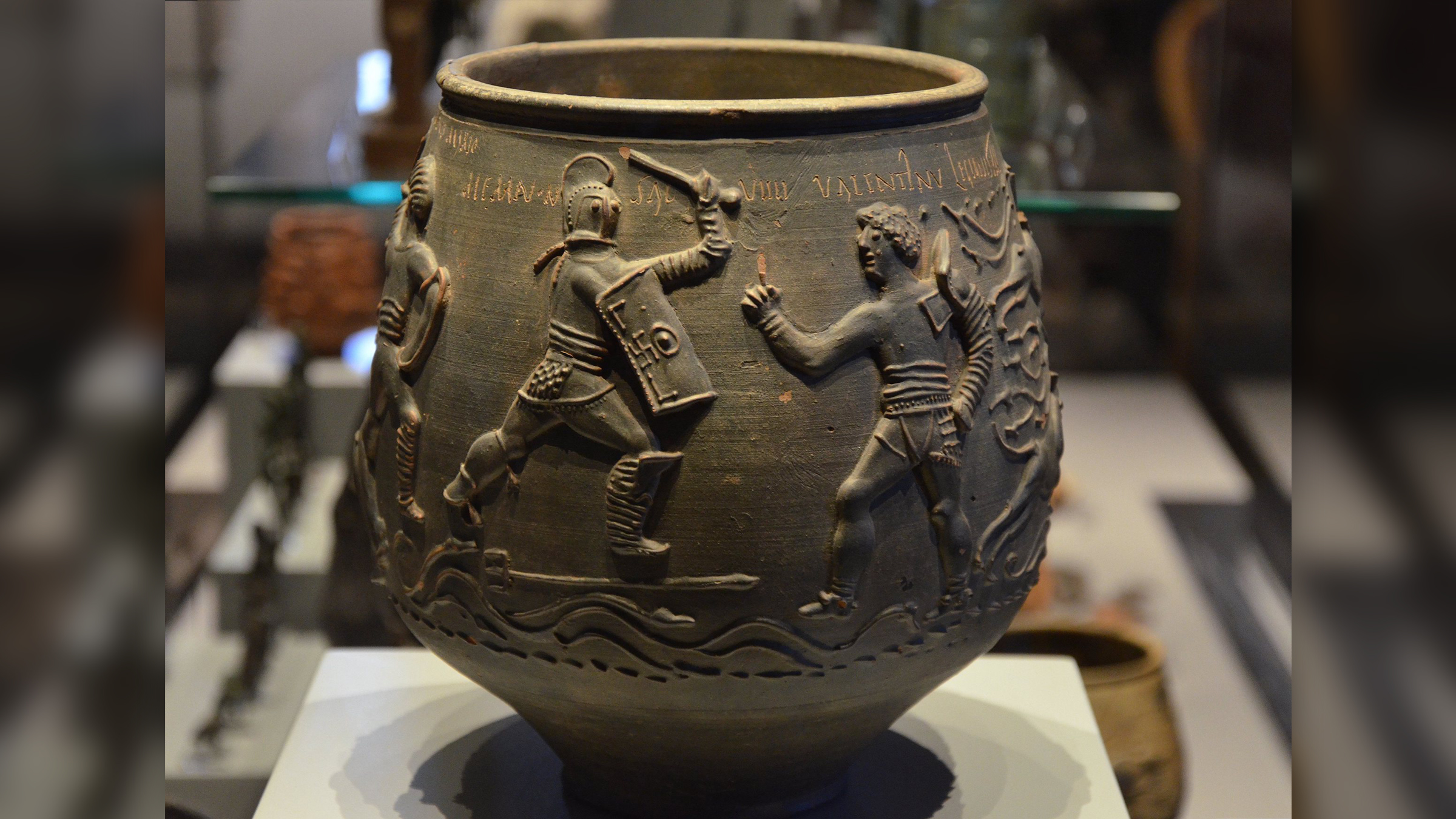Gladiators fought in Roman Britain, action-packed cremation urn carvings reveal
A new analysis of the famous Colchester vase indicates that gladiators fought in Roman Britain during the second century A.D.
Vivid depictions of battling gladiators on a clay vase are the first concrete evidence that these combatants duked it out in Roman Britain, new research finds.
The vessel, known as the Colchester vase, is well known to researchers; it was discovered in a Roman-era grave in Britain in 1853 and holds a person's cremated remains. However, nothing was known about the deceased, and it was unclear whether the vase had been crafted locally or in continental Europe, where gladiator fights were known to entertain audiences in the Roman Empire.
A forthcoming study, however, has revealed that the vase was made with local clay as a souvenir of a specific match in the second century A.D., giving researchers unprecedented insight into sporting events in the outskirts of the empire.
Related: Bloody, defeated gladiator drips gore in gruesome fresco uncovered at Pompeii
The town of Colchester, where the vase was found, is located in southeast England, about 60 miles (100 kilometers) from London. In Roman times, it was known as Camulodunum and boasted three theaters, as well as the only chariot racetrack in Britain. By the second century A.D., Camulodunum was a large city with a thriving pottery industry.
Measuring 9 inches (23 centimeters) tall and weighing over 2.2 pounds (1 kilogram), the Colchester vase depicts three gladiator scenes with three types of combatants: human-human, human-animal, and animal-animal. In one scene, "bestiarii" (beast fighters), labeled Secundus and Mario, are fighting a bear, while in another, Memnon and Valentinus fight as "secutor" (chaser) and "retiarius" (net man), a fight that pitted a lightly armored man against one with a trident and a net, as a metaphor for the fisherman and his prey. Valentinus is described as being in the 30th legion, which was stationed in northwestern Germany, and Memnon is annotated with the Roman numerals VIIII, meaning he fought and survived nine times.
Because of the intricacy of the decoration, it was long thought that the vase could not have been made in Britain. But a growing body of evidence for the pottery industry in Colchester allowed the research team to identify the vase as a locally made vessel dating to A.D. 160-200.
Get the world’s most fascinating discoveries delivered straight to your inbox.
Close examination of the inscription, previously assumed to have been created after the pot was fired, "shows it was made when the clay was soft, after the decoration had been applied," John Pearce, a member of the research team and a senior lecturer of archaeology at King's College London, said in an email to Live Science.
The vase was likely created as a type of commemorative cup that was then repurposed as a funerary urn.
The detailed replication of the gladiator scenes on the Colchester vase reflects "the choice of a key moment in the proceedings," Pearce said. "The inscription helps make this a special memento and probably echoes the kind of promotional hype that characterized the build-up to the fight, such as placards paraded with names of fighters."
Scientific analysis of the cremated bones have revealed that they are the remains of a robust man who was older than 40 when he died. His teeth showed that he did not come from Colchester but rather southwestern England, or possibly from beyond the British Isles. But he wasn't one of the gladiators mentioned on the vase. "We don't think there's a strong case for making the remains those of a performer," Pearce said.
Steven Tuck, a professor of history and classics at Miami University in Ohio who was not involved in this study, told Live Science in an email that "the cremated individual could have been a fan of gladiators in general or of a particular gladiator."
The use of the gladiator vase as an urn, however, may suggest an even more personal connection. "I think it more likely he was associated with this event in some way," Tuck said. "Since we know some of the trainers were former gladiators themselves, he could have easily been a retired gladiator who was still involved in the spectacle."
With its gladiatorial themes and locally sourced clay, the Colchester vase is a remarkable example of Roman-style games taking place in a far-flung part of the empire. Given the lack of written descriptions of events like these in Britain, the Colchester vase provides conclusive evidence that gladiatorial contests occurred there and that people took home souvenirs of their adventures.
"Identifying evidence that gladiatorial combats likely took place right here in Colchester 2,000 years ago is incredibly exciting," Colchester Councillor Pam Cox said in a statement. "We are grateful to all the researchers who have helped uncover this and other secrets from the vase."
The Colchester vase will be featured in an exhibition on gladiators at Colchester Castle starting July 15.

Kristina Killgrove is a staff writer at Live Science with a focus on archaeology and paleoanthropology news. Her articles have also appeared in venues such as Forbes, Smithsonian, and Mental Floss. Kristina holds a Ph.D. in biological anthropology and an M.A. in classical archaeology from the University of North Carolina, as well as a B.A. in Latin from the University of Virginia, and she was formerly a university professor and researcher. She has received awards from the Society for American Archaeology and the American Anthropological Association for her science writing.



